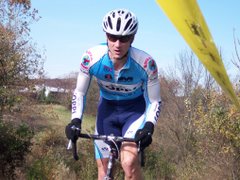 |
| From 2009-6-21 Tour of Washington County SR |
This was the second running of the Tour of Washington County and the first year that the race was run as a true stage race with a general classification based upon time, rather than points. Overall, the race was a story of attrition. We started the RR on Saturday with 75 guys, but only 50 were given finishing times. Only 49 guys showed up for the TT the next day and only 30 guys finished the crit. I ended up 25th in the RR, 20th in the TT, and 27th in the pack finish of the crit. In GC, I was 20th overall -- an improvement from last year, but not what I was hoping for.
Weather: Weekend conditions were windy and warm – approximately 80 degrees with high winds from a storm that blew through the area on Saturday morning. We fought a nasty wind throughout the road race. During the TT on Sunday I had to get out of the aero position once to steady the bike after a gusting crosswind. The wind was even a factor in the crit, dictating the best spot to be in the pack during certain legs of the course.
Smithsburg RR. This race seemed harder than it did last year, when I stayed with the main field until the penultimate hill and rolled in for 26th a few seconds after the finishers. This year the race was converted to a true stage with a time-based general classification. I’m not sure if the new format changed the racing or if the extremely windy conditions made the difference, but the race certainly seemed much harder.
I don’t look at my power meter during a road race, except perhaps to take a peek at my HR. But downloading the data later tells the story pretty well. According to my power meter, the race lasted almost exactly two hours – all of which were spent at a normalized power (NP) within a few watts of my functional threshold power (FTP). My 20-min NP was 20 watts beyond my FTP. Despite that effort level, I still missed the field split on lap 5 of 6. Once the split occurred, the group I was in disintegrated and everyone was left more-or-less on their own. I stayed on the gas the best I could and rode mostly solo to the end. Strangely, I was only 3:49 behind the winner despite riding solo for 1.5 laps! I started cramping a little in my calves in lap 3 and was cramping in lap 5 when I was dropped.
 |
| From 2009-6-21 Tour of Washington County SR |
Boonsboro TT (20k). Finished 20th in a time of 30:03, an improvement of more than two minutes over last year’s time. I struggled a bit during the ride and my HR never really came up to threshold until the very end. For some reason I wasn't able to hold my threshold power and I didn’t climb much beyond threshold. I think the problem was lack of freshness and perhaps inadequate recovery from Saturday's RR. Perhaps I should have stayed out of the sun while waiting for Jean to finish! But it was cool to see my teammate, Christian, win the Cat 4 women’s race with a huge margin.
 |
| From 2009-6-21 Tour of Washington County SR |
Williamsport Crit. Hung on by the skin of my teeth in this crit. Pace was high from the beginning with 3 time-bonus premes up for grabs and some tight GC races going on, including with my two teammates, Tom and Nate. Unfortunately, I was hanging on for dear life the entire race and couldn't do much to help them. I think we shed at least half the field by the end. 28 laps and more than 28 600-watt spikes in power. Ouch.
 |
| From 2009-6-21 Tour of Washington County SR |







